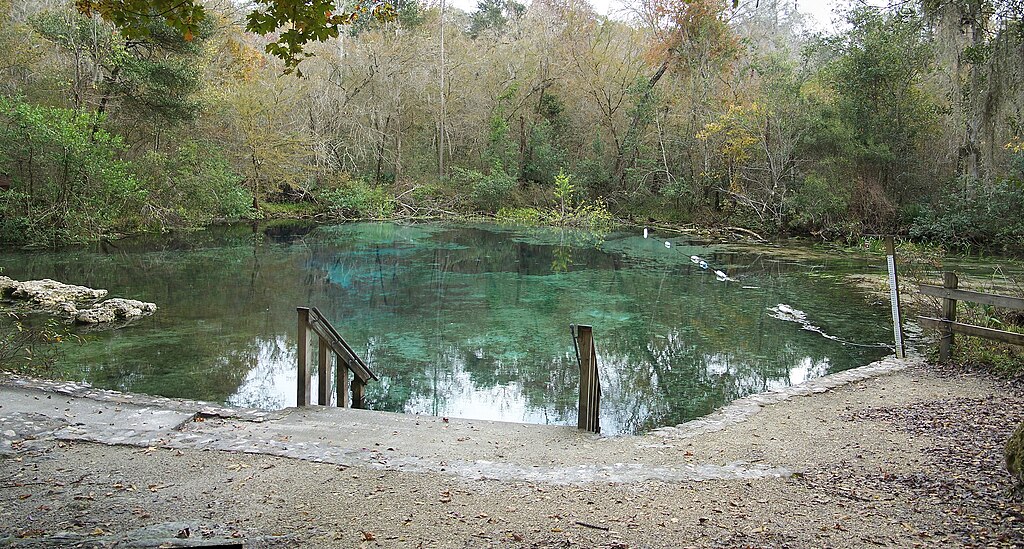The state of Florida is home to hundreds of natural springs. You might have seen images of these crystal-blue spots online. Some are inhabited by manatees while others are open to swimmers and kayakers.
And others are privately owned and operated, while some are state parks open to the public. They remain more or less the same temperature year-round and are essential road trip stops for those traveling through Florida.
Natural Springs in Florida
Weeki Wachee Springs State Park

One of the most well-known springs, Weeki Wachee Spring is home to a live mermaid show since 1947. Named for the Seminole name for “little river,” the deepest points have never been reached but are assumed to be at least 400 feet deep.
The mermaid show has been visited by musicians and celebrities over the year. In addition to this uniquely Florida experience, the park has a seasonal water park, boat rides, scuba diving, and wildlife spotting.
Where to Stay Nearby: For a full service hotel, stay at the nearby Holiday Inn Exp Stes Spring in Spring Hill. If you’re camping or traveling with an RV, Cody’s RV Park is one of many facilities in the area with a bathhouse and swimming pool.
Ginnie Springs
A favorite getaway of Florida natives, privately-owned Ginnie Springs is on the Santa Fe River. It’s around 72 degrees year-round with plentiful caverns, making it popular for swimming, snorkeling, canoeing, tubing, and scuba diving. There’s even a PADI facility onsite that rents the necessary equipment.
Where to Stay Nearby: Ginnie Springs has its own accommodations, including rustic campsites or those with electricity. There are also cabins for larger groups.
Silver Springs State Park

Called Florida’s first tourist attraction, Silver Springs State Park dates back to the 1870s but didn’t become a state park until 2013. The namesake springs are just one of at least 30 in the Silver River, which you can see by the glass bottom boats that date back to the 1920s and were built by Thomas Edison. The Tarzan films from the 1930s were filmed here.
Where to Stay Nearby: Just across the street from the park gates, the vintage-inspired Sun Plaza Motel is as close as you get. It’s also a good base for exploring Ocala National Forest.
Devil’s Den
Perhaps the most photogenic spring, Devil’s Den Prehistoric Spring is a subterranean spring with an opening from collapsed wood, only letting in a small amount of light. It’s privately owned and opened to licensed scuba divers and snorkelers, but not for solo divers.
Rentals of equipment are available onsite. Skeletons of extinct animal species have been found within the caverns. Nearby Blue Grotto is another popular cavern dive site.
Where to Stay Nearby: Devil’s Den has its own campsites and four cabins and nearby Two Hawk Hammock also has a guesthouse. Around 30 minutes away in Gainesville are more options, including Magnolia Plantation Bed and Breakfast Inn.
Homosassa Springs State Park

The first tourists came to Homosassa Springs in the 1880s, where they came to swim and admire the wildlife. Today, it’s a popular spot to see manatees, which live in the springs year-round and can be seen from the underwater observatory or boat tours.
Visitors can also spot alligators, deer, and bears. But the best known is Lu the Hippo, the oldest hippopotamus in North America. He’s even been on TV!
Where to Stay Nearby: TradeWinds Homosassa Marina Resort is a villa rental community with tennis and swimming facilities, while Homosassa River RV Resort is the perfect place to park your RV for the night or the week.
Fanning Springs State Park

One of 27 first magnitude springs in Florida, Fanning Springs is fed by the Suwannee River and produces over 65 millions of gallons of water per day. A number of species of fish inhabit the spring, which can be viewed on boat tours. The boardwalk showcases the cypress knees that come up from the ground.
Where to Stay Nearby: The state park has five two-bedroom cabins available for rent that can accommodate up to 6 people each. They have fireplaces, screened porches, and kitchenettes.
Three Sisters Springs

A part of the greater Crystal River area, Three Sisters Springs is the most popular part the river to see manatees, especially during the winter months when the creatures flock here. Snorkeling and swimming is available in this area, which can be booked with a tour operator. Visitors can also admire the bright blue water from the boardwalk.
Where to Stay Nearby: Plantation on Crystal River is only five minutes away and also has a tour operator that will take you to the springs on snorkeling and sightseeing tours. The rooms are comfortable and the resort also has a pool and restaurants.
Blue Spring State Park

Located on the St. John’s River, Blue Springs State Recreation Area and Park swells during the summer months with guests hoping to swim in the clear water and even spot some wildlife.
In the winter months, it’s not uncommon to see many manatees. Visitors can go fishing and boating in the water and also wander the boardwalk. There’s also a historic home that belonged to early settlers.
Where to Stay Nearby: Blue Spring State Park has its own onsite accommodations, including six two-bedroom cabins and RV or tent campsites. Just outside the park, Hontoon Landing Resort & Marina has spots to park your boat and Days Inn by Wyndham Orange City/Deland has basic rooms for cheap.
Ponce De Leon Springs State Park

The swimming area at De Leon Springs State Park is open year-round since it remains more or less the same temperature. Something else that sets this park apart is the Sugar Mill Restaurant, a longtime Central Florida favorite where you can cook your own pancakes at tableside griddles. The park also offers kayak rentals and boat tours and also has playgrounds and a butterfly garden.
Where to Stay Nearby: The Deland Hotel is around 15 minutes away from the park in Deland. This boutique property is set in a historic building with daily wine receptions and an in-house sushi bar.
Wekiwa Springs State Park

Set on the Wekiva River, Wekiwa Springs was once inhabited by Timucuan tribes, who used the land for hunting and fishing. Ideal for swimming, the park also has thirteen miles of trails for biking and walking as well as horseback riding. The river is also accessible by canoe and kayak, which are available for rent onsite.
Where to Stay Nearby: Wekiwa Springs State Park has its own campground with both full-service sites and primitive camping.
Manatee Springs State Park

As the name implies, Manatee Springs State Park is an incredible place to go to see the creatures, especially in winter months. Another first magnitude spring, Manatee Springs is great for scuba diving, snorkeling, and swimming because of the clear water and relatively warm temperature. Kayaking and canoeing is also available through onsite rentals. There’s also a casual eatery and biking trails.
Where to Stay Nearby: Like other nearby state parks, Manatee Springs has 80 campground sites for tents and RVs and hot showers.
Troy Spring State Park

What sets Troy Springs State Park apart from the others on this list is its depth, which is 70 feet deep. It makes a popular spot for licensed scuba divers as well as snorkelers and swimmers.
It also has shallow water, where you’ll find the ruins of the Civil War steamboat that wrecked here in 1863. The park also has a nature trail and a dock for launching canoes and boats onto the Suwannee River.
Where to Stay Nearby: If you’re also visiting Ginnie Spring, you can stay at their campgrounds and cabins. Otherwise, Fairfield Inn & Suites by Marriott Lake City is around 45 minutes away and has comfy rooms and amenities.
Wakulla Springs State Park

Located near Tallahassee, Wakulla Springs is perhaps best known as being one of the filming locations for the classic monster movie The Creature From the Black Lagoon.
Countless animal species call the springs home, including alligators, manatees, and birds. Riverboat tours inform guests about the wildlife and glass-bottom boats showcase what lies beneath. Swimming is available in the summer.
Where to Stay Nearby: Wakulla Springs has one of the most unique state park accommodations. Wakulla Springs Lodge was built in 1937 by wealthy local Edward Ball. The dining room overlooks the springs and has 27 guest rooms.
Ichetucknee Springs

The namesake river feeds into Ichetucknee Springs, a wetlands area first designated as a natural landmark in 1972. During summer months, visitors can go tubing down the river. Cave certified scuba divers can go to the beloved Blue Hole, a bucket list dive. The park is also open to swimming, snorkeling, and hiking.
Where to Stay Nearby: Ichetucknee Cottages at the Smoakhouse Ranch is a unique bed and breakfast in nearby Branford that offers rustic cottages, walking trails, and daily breakfast.
Rainbow Springs

Scientists have determined that the area around Rainbow Springs has been inhabited and used as a water source for nearly 10,000 years. The park includes the springs itself, a tubing area, and a campground. Activities include swimming, canoeing, and kayaking. Formerly a privately-owned facility, the state’s fourth-largest spring is now open to all.
Where to Stay Nearby: Rainbow Springs has RV and tent campsites that have water and electricity for all your overnight needs. There’s also a bathhouse, laundry, and playground area.
Additional Springs to Visit
Salt Springs Recreation Area
Located within the Ocala National Forest, Salt Springs has deposits of potassium, magnesium and sodium salts, giving it its name. Canoe rentals are available to explore the springs further. Swimming and fishing are other activities within the area.
Where to Stay Nearby: The recreation area has a campground with full hookup campsites for RVs and primitive tent sites.
Alexander Springs Recreation Area
Alexander Springs is easy to enjoy with its natural water park that is accessible from the shore. Canoeing, fishing, and scuba diving are also available.
Where to Stay Nearby: The recreation area’s campsite has 67 spots for tents and RVs, including some open to reservations, while others are first come, first serve.
Juniper Springs Recreation Area
Also in the Ocala National Forest, Juniper Springs has a swimming area as well as trails constructed by the Civilian Conservation Corps in the 1930s.
Where to Stay Nearby: The recreation area’s campground has 79 shaded spots and was named one of ReserveAmerica’s Top 100 Family Campgrounds in the United States.
Silver Glen Springs Recreation Area
Yet another Ocala area springs, Silver Glen Springs is connected to Lake George, one of the largest along the St. Johns River. In addition to being a popular recreation spot, it’s also an archaeological site. Snorkeling and canoeing are allowed, but no diving.
Where to Stay Nearby: Silver Glen doesn’t have camping, but there are a dozen other camping areas within Ocala National Forest.
Are there any we left out? Let us know in the comments!

This post contains affiliate links. All photos, unless noted, are the property of the author.


Correction: Ponce De Leon Springs is located in Ponce De Leon, FL (panhandle). The spring you are describing, which is labeled correctly underneath the above heading, is De Leon Springs, De Leon Springs, FL (central FL). These are two different springs and locations..